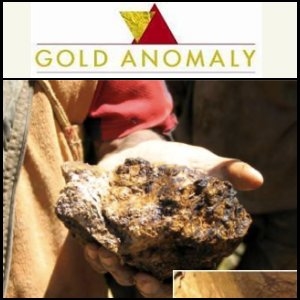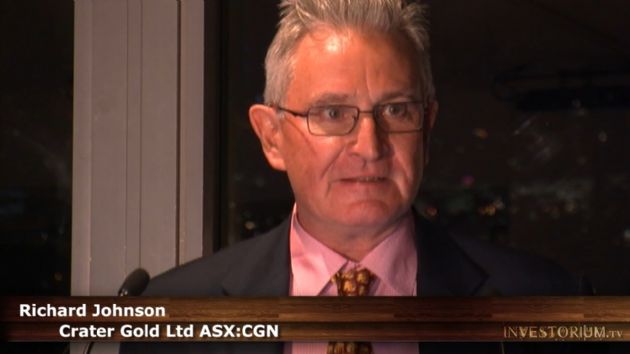
Drill intercepts show potential for major mineral deposits
Sydney, Feb 28, 2012 AEST (ABN Newswire) - Gold Anomaly Limited ( ASX:GOA) is pleased to announce that a recently completed detailed review of geophysical and drill core assay data has concluded that multiple massive sulphidei intercepts at the A2 aeromagnetic anomalyii near Croydon, North Queensland may indicate the presence of a major new mineral deposit. The polymetallic mineralisation, which includes tin and silver as well as copper, zinc and lead, has similarities in mineral composition to the large Dajing polymetallic-tin deposits of Inner Mongolia, China.
ASX:GOA) is pleased to announce that a recently completed detailed review of geophysical and drill core assay data has concluded that multiple massive sulphidei intercepts at the A2 aeromagnetic anomalyii near Croydon, North Queensland may indicate the presence of a major new mineral deposit. The polymetallic mineralisation, which includes tin and silver as well as copper, zinc and lead, has similarities in mineral composition to the large Dajing polymetallic-tin deposits of Inner Mongolia, China.
The metal content of the intercepts at A2 are particularly significant given the prevailing growth in world metal markets in recent years. Assay results from thick (2 to 13m wide) massive sulphide filled fractures in six of nine widely spaced holes previously drilled by GOA at A2 are particularly impressive, including hole A2-001 returning a 5m massive sulphide intercept averaging 8% Zn, 180g/t Ag, 0.58% Sn and 0.57% Cu. Massive sulphide zones of 2m or greater down-hole width are present in six of the nine exploration holes, as shown in Figure 1 - Plan of the A2 drill pattern showing weighted average metal assays for important massive sulphide intercepts.
Gravityiii and Induced Polarizationiv (IP) anomalies mapped by ground surveys indicate that as much as 600m of strike of the A2 anomaly, particularly eastward of hole A2-008, remains to be drill tested. Based on the number and apparent strike extent of mineralisation discovered in the initial exploration drilling at A2, a target of between 2 and 10 million tonnes of high-value massive sulphide could be discovered at A2. (The potential quantity is conceptual in nature, there has been insufficient exploration to define a Mineral Resource, and it is uncertain if further exploration will result in the determination of a Mineral resource).
The results to date warrant resumption of in-fill drilling and down-hole geophysics to establish the full extent of these impressive massive sulphide zones. Upcoming activities will focus on measuring the vertical and lateral continuity of the sulphide intercepts and the polymetallic-tin metal content.
Project Background
Gold Anomaly holds 10 Exploration Permits Mining (EPM) in the Croydon region of North Queensland that cover aeromagnetic and gravity anomalies delineated during Queensland Government aerial surveys.
The Croydon-Mt Isa region is underlain by Proterozoicv rock formations that are host to a number of large base metal mines such as Cannington (Pb-Zn-Ag), Century (Pb-Zn-Ag), Ernest Henry (Cu-Au), George Fisher (Zn-Pb-Ag) and Mt Isa (Zn-Pb-Au-Cu). It therefore is a region with massive mineral endowment.
Notably, all of these significant mineral deposits are associated with geophysical anomalism and the exploration program being conducted by GOA is targeting similar anomalies believed to be caused by mineralisation believed to have potential to deliver similar major mine discoveries.
The Croydon Polymetallic project emerged from analysis of aerial geophysical surveys undertaken by the Queensland Government that detected magnetic and/or gravity anomalies in Proterozoic rock strata underling a relatively thin cover (100-130m) of Mesozoic sediments. GOA selected nine aeromag (A1, A2, A5, A13, A15, A18, A25, A27 and A33) and three gravity (G1, G2 and G3) anomalies for follow-up exploration.
Between 2006 and 2008, two of the aeromag anomalies (A1 and A2) were subjected to ground gravity, IP surveys and scout diamond drilling with exceptional success. Both anomalies were found to overly massive fracture-fill vein and disseminated sulphide mineralisation containing commercially attractive concentrations of zinc, silver, tin, copper and lead at the A2 anomaly and strongly anomalous copper-silver at the A1 anomaly.
The economic potential of the A2 intercepts has been greatly enhanced over the past few years as metal prices have risen strongly in response to rapidly rising demand from Asia.
Potential for Another New Discovery at the G1 Anomaly
In addition to the review of earlier drilling at A1 and A2, during the 2011 field season new geophysical exploration was undertaken to investigate four of the other airborne anomalies (G1, G2 and G3 gravity and A5 aeromagnetic).
Whilst results of ground gravity and IP surveys of the A5, G2 and G3 airborne anomalies were not encouraging, both gravity and IP results at G1 confirmed the presence of a large, 1500 X 500m anomaly commencing at a depth of approximately 100m from surface. The G1 anomaly is considered important as it could represent the cupola of an intrusive body and a possible tin granite source for the polymetallic-tin sulphides discovered in the A2 drilling. G1 is recommended for a drill test to establish the cause of the geophysical response during the 2012 field season.
Figure 1 is a plan of the nine A2 drill holes showing important massive sulphide intercepts. Metal contents are reported as weighted averages for the metal assays of the interval selected. The drill hole traces and intercepts are vertical projections to surface and show the along strike spatial distribution of the selected intercepts. Figure 2 shows the relative positions of the G1, G2 and G3 gravity anomalies and the A1 and A2 aeromagnetic anomalies. Figures 3 and 4 are sections with the down-hole locations of massive sulphide filled fractures. (See Link below)
The last series of diagrams (figure 5) shows the gravity anomaly at G1 from the surface gravity survey and below that image the coincident IP and gravity profiles and a plot the trace of a proposed exploration hole to determine the cause of the anomaly.
For the Full Announcement Please visit:
http://media.abnnewswire.net/media/en/docs/ASX-GOA-240036.pdf
Contact
Gold Anomaly Limited
T: +61-2-9241-4224
F: +61-2-9252-2335
WWW: www.goldanomaly.com.au
| ||
|






